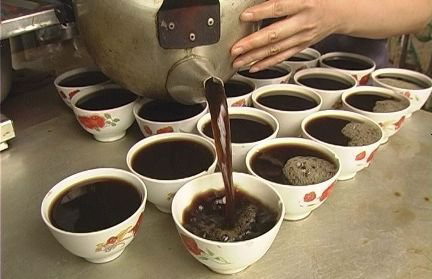The Chinese herbal tea or cold tea is a drink concocted from medicinal herbals to ease the summer heat in human’s body or sore throat caused by the dry winter.
|
 |
Drinking herbal tea is an age-old custom in Guangdong, Guangxi provinces, Hongkong and Macau special administrative regions, where the climates are damp and hot result in people living there easily suffer from excessive internal heat. In order to repel internal humidity and heat, people collect herbs which can clear away heat and dampness from mountains and valleys to concoct into herb tea.
With many years of practice, different herbal teas have been evolved for relieving different symptoms.
Herbal tea is drinkable in four seasons, which has the functions of relieving summer-heat and body’s internal dampness.
Herbal teas’ functions can be classified as inducing sweat, relieving the syndrome of cold, moisturizing dry-heat and clearing away dampness. Herbal tea for inducing sweat and relieving internal heat is suitable for the people who suffer from excessive internal heat. Medicinal herbs of honeysuckle, chrysanthemum, scutellaria are the main ingredients of this herbal tea, which is appropriate for drinking in Spring, Summer and Autumn.
Herbal tea for relieving the syndrome of cold is mainly made up by radix isatidis, suitable for drinking in four seasons.
Concocted by medicinal herbs of root of straight ladybell, fragrant colomonseal rhizome, tuber of dwarf lilyturf and white fungus, herbal tea for moisturizing dry-heat is effective in relieving cough and easing people’s parched mouth and the scorched tongue in Fall.
Herbal tea for clearing away internal heat and dampness is good for the people who have bad breath and red and sallow complexions. Its ingredients include honeysuckle, chrysanthemum and wild Tuckahoe, appropriate for summer drinking.
Generally, herbal tea should be drunk before it is getting cold. Since most of herbs are cold in drug property, drinking too much will harm to the spleen and stomach, especially for people who lack of vital energy and are easily to feel cold. Therefore, women in the menstrual period, children and the old people are unsuitable to drinking herbal teas.
If you have no idea about your physical condition, it is better to see the doctor of traditional Chinese Medicine to choose a right herbal tea for you.
Herbal tea stores once could be found everywhere in Lingnan region (which mainly covers Guangdong and Guangxi provinces). At first, the stores classified herbs and packed them into small packages to meet customers’ different needs, and then concocted herbal tea was sold at stores with very low price. Since herbal tea tastes bitter, some herbal stores offer preserved orange peel to customers for free to ease the bitter flavor. Besides herbal tea, fruit juice, dessert and soup are also the staples of some stores.
The earliest brand of Guangdong herbal tea is Wang Laoji, which was originated by Wang Zeban in 1828 and now it has become a household name in China. In July 2004, Wang Laoji herbal tea was even on the list of KFC’s drinks.
|
 |
Nowadays, herbal teas packed in fashionable cans and bottles have become popular on both the domestic and international markets. With the annual output of 2 million tons, herbal teas are exported to about twenty countries including the USA, Canada, Australia, Japan and France.
Herbal tea together with Guangdong opera, Guangdong cuisine and Cantonese is the representative of Lingnan culture.
When people who are from other provinces come to Guangzhou, the first thing he or she learns in there may not be speaking Cantonese but drinking herbal tea. Herbal tea culture is an embodiment of Lingnan culture, just like Guangzhou this big city which is magnanimous to many alien things at the same time gradually changes them unawares. When you are gradually accustomed to live in a Cantonese way, you will find that drinking herbal tea has become part of your daily life just like the Lingnan culture influences you unconsciously. Even many people who leave Guangdong for a long time still cherish the memory of different herbal teas.






 Interestingly, prolonged ingestion of raw foods can increase the risk of getting the cancer. This finding disputes the belief of some health advocates, which advocates raw food as the healthier alternative to cooked foods.
Interestingly, prolonged ingestion of raw foods can increase the risk of getting the cancer. This finding disputes the belief of some health advocates, which advocates raw food as the healthier alternative to cooked foods.

